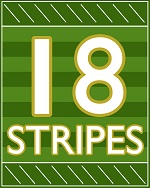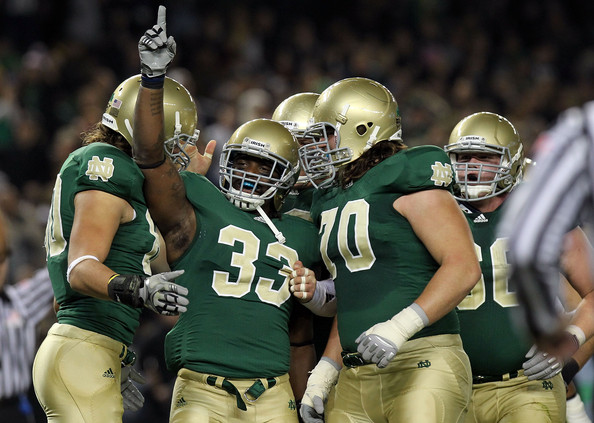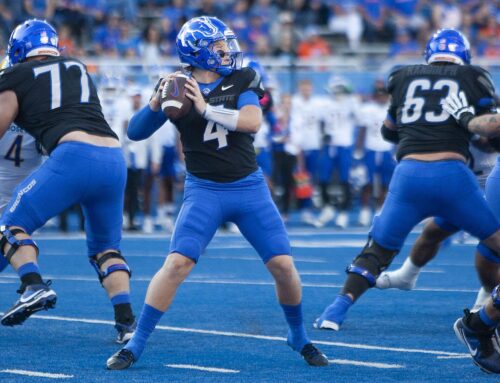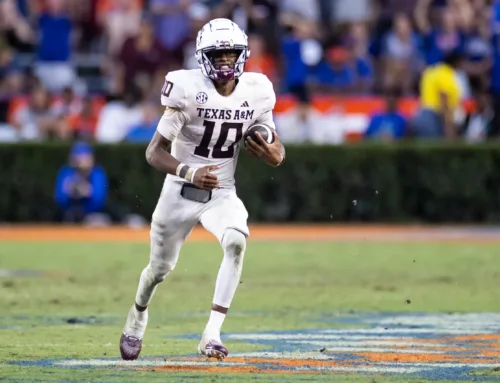Today I’m beginning a series that will look at the run success rate for the Notre Dame running backs since Brian Kelly arrived in 2010. I’ll look at each year, 7 posts in all, starting right now with Kelly’s maiden voyage in South Bend.
Heading into 2010 there was so much focus on Dayne Crist at quarterback but the situation at running back was intriguing at the time and really fun to look back at years later. Armando Allen and Robert Hughes were coming off the poor production of the late Charlie Weis era and looking for breakout senior seasons. Cierre Wood was the hyped redshirt freshman and possible new x-factor, while Jonas Gray lingered in the background dazzling with his physical gifts but as of yet unable to put it all together.
Run Success Definition
A play counts as a success if it gains 40% of yards on first down, 60% of yards on second down, and 100% of yards on third or fourth down. If the team is behind by more than a touchdown in the fourth quarter, the benchmarks switch to 50%/65%/100%. If the team is ahead by any amount in the fourth quarter, the benchmarks switch to 30%/50%/100%.
There was hope that Kelly’s arrival would immediately bring more production if not more explosiveness to the Irish run game. Neither really happened in 2010. If you recall, the Irish hadn’t rushed for 2,000 yards in a single season in forever and quite frankly never sniffed that benchmark under Charlie Weis.
2010 Rushing Stats
Wood, 119 attempts, 603 yards, 5.07 average, 3 TD
Allen, 107 attempts, 514 yards, 4.80 average, 2 TD
Hughes, 68 attempts, 300 yards, 4.41 average, 2 TD
Gray, 20 attempts, 100 yards, 5.00 average, 0 TD
For 2010, Notre Dame only mustered 1,646 yards as a team with just 7 touchdowns from the tailbacks. Wood’s 5.07 rush average was okay and on the surface signaled a bright future. Gray’s 5.0 YPC was fine with a real small sample size, while Allen (4.8) and Hughes (4.4) were pretty average nationally in this department. Strictly speaking, this was not a memorable season for the ground game which makes sense because this remains, by a fair margin, the worst offense of the Brian Kelly era.
Run Success (2010)
| Player | 1st/2nd + | 1st/2nd – | 3rd/4th + | 3rd/4th – | Total |
|---|---|---|---|---|---|
| Wood | 42 | 60 | 6 | 11 | 40.3% |
| Allen | 53 | 46 | 5 | 3 | 54.2% |
| Hughes | 32 | 31 | 4 | 1 | 52.9% |
| Gray | 8 | 8 | 2 | 2 | 50.0% |
Sneaky Good Armando?
The knock on Allen prior to his senior season was that he couldn’t stay healthy or break the long runs that would be expected from a smaller speed back. To start 2010 he was actually much improved in the latter category with 11 runs of 10+ yards, 2 runs of 20+ yards, and one 30-yard run on his 107 total carries.
Then he got hurt. Allen was injured against Western Michigan, tried to gut out an effort against Navy, and ended his career missing the final 5 games of the season following hip flexor surgery. However, Allen had the best run success rate on the team and it makes you wonder how the Navy and Tulsa games might have gone if he was fully healthy or able to play.
Still, when you’re under 5 YPC as Allen finished there weren’t enough really long runs to off-set the bad runs which tended to be 1 or 2 yards on 1st down instead of 3 yards. Piling those up over the quarters can really ding your average. However, the success rate bares out what I remember prior to Allen’s injury in that he was much improved from 2009.
Sneaky Bad Cierre?
One of the more shocking revelations which I didn’t expect was just how poor Wood’s performance was in success rate which was way, way below everyone else. I was expecting one of George Atkinson’s seasons from 2012-13 to be a poster child for quality YPC but poor run success rate yet Cierre’s 2010 takes the cake…for now.
Wood’s 11 failed runs on 3rd and 4th down stick out like a sore thumb and look particularly damning. However, we’re here for some context! A full 8 of those runs came from 3rd & 7+ yards to go situations, so clearly Wood was used as the home-run hitter on the rare occasion the Irish didn’t throw the ball on these down and distances.
A super crucial missed 3rd down? How about the first series against Navy, 3rd & Goal from the 3-yard line and Wood got stuffed at the goal line. Dayne Crist would be stoned on a sneak on 4th down and it was all down hill from there, to put it lightly.
Hughes’ Up & Down Finish
Robert Hughes started the season as an afterthought in the Kelly pecking order not even picking up a single carry in September. It wasn’t until the middle of the third quarter against Boston College in the 5th game that his first carry happened. By the Tulsa game on October 30th Hughes had only 1 carry in the first half of a game.
What’s more, 5 out of his first 11 successful runs came in the second half of a blowout against Western Michigan. I still vividly remember Broncos head coach Bill Cubit commenting after the game that a guy that big with light feet was Notre Dame’s third option.
Everyone remembers Hughes’ fantastic performance against USC where he put up 8 successful runs to just 2 unsuccessful carries with 2 out of his 4 season total runs of 10+ yards. Allen had a couple really productive games (8 successful runs to 4 failed against both Michigan State and Pitt) but given the circumstances and Rees’ poor play the performance by Hughes against the Trojans was the top of the season.
Based off that Coliseum performance, Hughes got the rock a ton in the bowl game (27 carries, still the most for a RB in the Kelly era) against Miami but really struggled with 19 non-successful runs. Wood scored on a long run against the Hurricanes which helped what was otherwise a really grind-it-out rushing performance especially compared to how Notre Dame dominated the scoreboard (30-3 through 3) until the 4th quarter.
Fun Notes from 2010
How bad was Western Michigan in 2010? The Irish didn’t have a single successful rushing attempt from a running back in the first half and still won by 24 points. That’s not exactly a compliment for the Irish, either.
Following his heroic performance against USC, Robert Hughes opened the bowl game against Miami with 5 straight unsuccessful runs.
Allen’s consistency cannot be understated. Until his injury against Western Michigan he averaged 8.1 successful runs per game while his games against Purdue and Boston College were the only on the season where a running back had 10 successful carries.
Notre Dame officially ran the ball just 46.2% of the time in 2010 a Kelly-era low by a considerable amount. Going over the play-by-play for the entire season even that figure felt high. I should’ve tracked it from the beginning but I wouldn’t be surprised if the number of non-kneel down offensive series with 1 or zero running back carries was north of 40% overall. It was shocking how long of stretches there would be without running the ball to any great degree and this introduction from Kelly certainly left an indelible mark on many Irish fans.
I was shocked to see how poor Wood’s season finished, especially given the 4-game win streak through the bowl game. I’m curious to see how much better he got in 2011 but to finish his first season Cierre had unsuccessful runs of 8, 8, 8, 8, and 6 over the final 5 contests.
Most Successful Runs in a Win: 16, Army
Most Successful Runs in a Loss: 10, Michigan, Michigan State, Navy (tied)
Fewest Successful Runs in a Win: 11, Western Michigan
Fewest Successful Runs in a Loss: 9, Stanford
3rd/4th Down Success Rate: 50.0%





I’m not sure there is a player out there as fondly remembered as Hughes, for such a small reason (in sample size, not importance). God that drive against USC is a thing of beauty.
True dat.
I also think it (unfairly IMO) caused Hughes’ stock to rise to an unrealistic level for many Irish fans. I can remember some early OFD days arguing that he just wasn’t fast enough to play in the NFL.
He ran a 4.89 so, yeah.
Thanks, this is really interesting stuff. Where do you pull these stats from?
I just rolled up my sleeves and went through the play-by-play of every game.